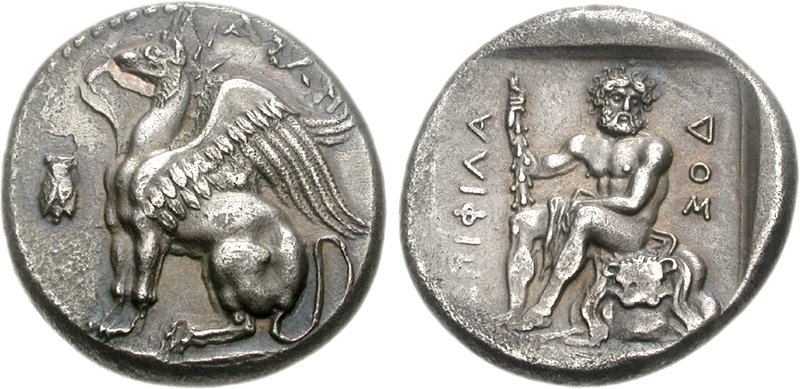AC 106 - Abdera, silver, staters (411/10-386/5 BCE)
From SILVER
410 BCE - 385 BCE Silver 11,987 kg
Description
| ObverseInscription or printing placed on the obverse.: | ABΔH(PITEΩN) (Greek).Griffin seated left, cicada to left, ABΔH to right. |
| ReverseInscription or printing placed on the reverse.: | Légende EΠI + nom au génitif. (Greek).Herakles, nude, seated left, head facing slightly right, on lion skin draped over rocks, holding in his right hand club set on his right knee, EΠI ΦIΛA-ΔOΣ around, all within incuse square. |
Mint and issuing power
| MintIdentifies the place of manufacture or issue of a numismatic object.: | Abdera | Ancient regionAncient region.: | Thrace | Modern countryModern country: Greece | AuthorityIdentifies the issuing power. The authority can be "pretended" when the name or the portrait of X is on the coin but he/she was not the issuing power. It can also be "uncertain" when there is no mention of X on the coin but he/she was the issuing power according to the historical sources: |
Chronology
| FromIdentifies the initial date in a range assigned in a numismatic context. | 410 BCE | toIdentifies the final date in a range assigned in a numismatic context.. | 385 BCE | PeriodTime period of the numismatic object.: Classical 480-323 BC |
Physical description
| MetalThe physical material (usually metal) from which an object is made.: | Silver |
Median weightMedian of the weights of numismatic objects (in grams). in grams | 12.45 | DenominationTerm indicating the value of a numismatic object. Examples: tetradrachm, chalkous, denarius.: | stater |
StandardStandard.: |
Image

AC106 Abdera.jpeg [1]
References
| Die study referencePublication of the study: | May 19661May 1966 | ||
| Coin series referenceReference to coin series study: | RQEMAC2RQEMAC, n° 106 | ||
Obverse dies distribution
| FrequencyFrequency of specimen in distribution. ᵖ | Number of obversesNumber of obverse dies. ᵖ (o) | % (o) | Number of coinsNumber of coins. (n) | % (n) | Die nameName(s) of the die(s). |
| 1 | 15 | 53.57 | 15 | 28.3 | 201, 206, 214, 218, 230, 231, 247, 248, 249, 250, 251, 252, 254, 276, 278 |
| 2 | 8 | 28.57 | 16 | 30.19 | 202, 203, 204, 205, 215, 229, 253, 275 |
| 3 | 2 | 7.14 | 6 | 11.32 | 212, 228 |
| 4 | 1 | 3.57 | 4 | 7.55 | 277 |
| 5 | 1 | 3.57 | 5 | 9.43 | 216 |
| 7 | 1 | 3.57 | 7 | 13.21 | 213 |
| Total | 28 of 28 | 99.99 | 53 of 53 | 100 |
Reverse dies distribution
no distribution is available
Quantification
| Number of obversesNumber of obverse dies. ᵖ (o) | 28 | Number of singletons (o1)The number of singleton coins. ᵖ | 15 |
| Number of reverse diesNumber of reverse dies. (r) | NC"NC" is not a number. | Number of coinsNumber of coins. (n) | 53 |
| Coins per obverse dieNumber of coins per obverse die. (n/o) | 1.89 | Coins per reverse dieNumber of coins per reverse die. (n/r) | |
| Reverse per obverse ratioRatio of obverse dies divided by reverse dies. (r/o) | Percentage of singletons (o1)number of coins (n) divided by the number of singletons (o1) ᵖ | 53.57 % | |
| Original number of dies (O) (Carter 1983 formula)The estimation of the number of coins according to Carter 1983 ᵖ | 48.14 | Coins struck if 20,000 as average productivity per dieCoins made if the average productivity for obverses (according to Carter) is 20,000. ᵖ | 962,800 |
| Original number of dies (O) (Esty 2011 formula)The estimation of the number of coins according to the singleton formula in Esty 2011 ᵖ (O) | 59.36 | Survival rate if 20,000 as average productivity per dieSurvival rate if average productivity is 20,000. ᵖ | 0.00006 |
| Coverage (o = % of O) (Esty 1984 formula)Esty 1984 - coverage (% of O) ᵖ (o = % of O) | 71.7% | Die productivity if survival rate 1/2,000Average productivity if survival rate is 1/2,000. ᵖ | 2,201.91 |
| Weight of silver (in kg) if 20,000 coins per die (O = Carter formula)Carter 1983 * Median weight * 20000 (*10 if gold or electrum) ᵖ | 11,987 kg <br /> 11,987 kg | Die productivity if survival rate 1/5,000Average productivity if survival rate is 1/5,000. ᵖ | 5,504.78 |
Remarks